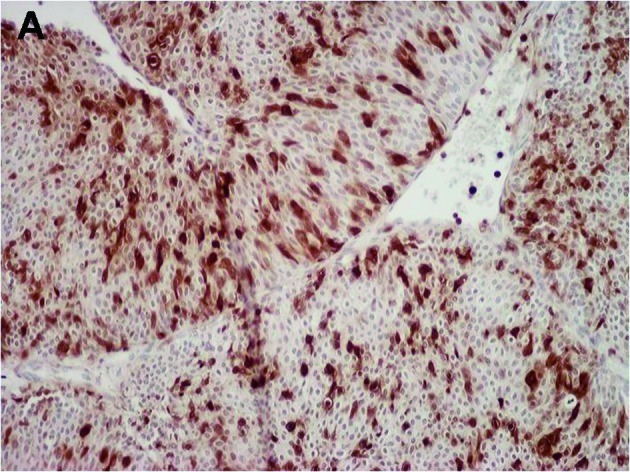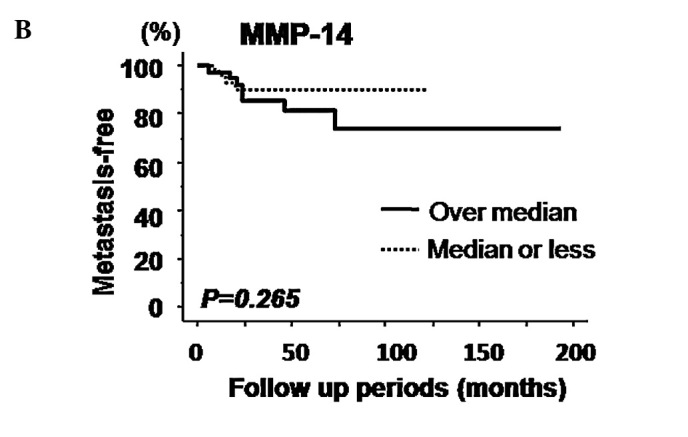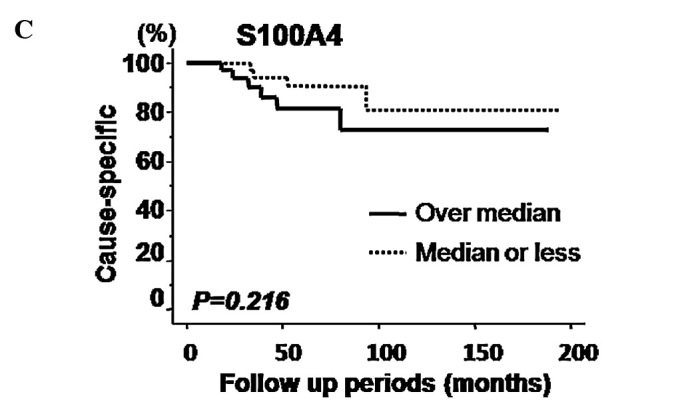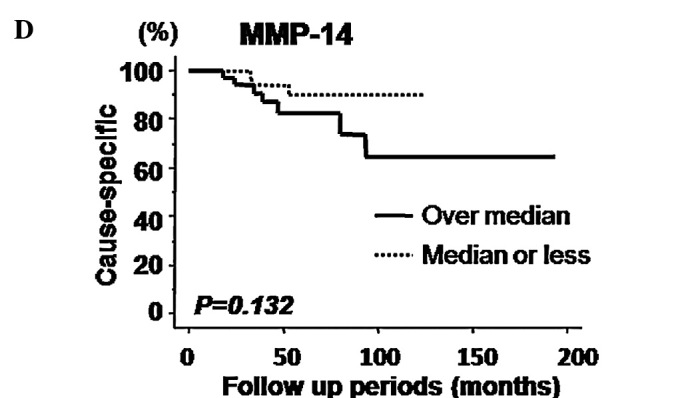Abstract
Various therapeutic modalities are available for treatment of bladder cancer, and their effectiveness and patient outcome often depend on cancer cell invasiveness. However, the mechanisms underlying the early steps of bladder cancer cell invasion remain unknown. This study aimed to clarify the relationships between S100A4 expression and bladder cancer invasion of surrounding muscles, prognosis and expression of matrix metalloproteinase (MMP)-14 in patients with organ-confined bladder cancer. S100A4 and MMP-14 expression was analyzed in 85 cases of organ-confined (pTa, pT1 and pT2) bladder cancer using immunohistochemical technique. The expression levels were compared among the pTa, pT1 and pT2 tumors. In addition, the predictive values of S100A4 or MMP-14 expression for muscle invasion, metastasis and survival were investigated, as was the possible correlation between the expression of the two proteins. The proportion of S100A4-positive cancer cells in pT2 tumors (53%) was significantly higher (p<0.001) than in pTa (38.7%) or pT1 (40.9%) tumors; there was no difference between pTa and pT1. The results were similar for MMP-14 expression, which was significantly correlated with S100A4 expression (r=0.360, p<0.001). S100A4 expression predicted metastasis-free survival (p=0.009), but not cause-specific survival. The results implicated S100A4 in the early steps of muscle invasion via MMP-14, but not for mucosal invasion. S100A4 is therefore a potential therapeutic target for bladder cancer, and its expression is a risk factor for muscle invasion in patients with superficial tumors. In addition, S100A4 expression may be a useful prognostic factor for metastasis in patients with organ-confined bladder cancer.
Keywords: bladder cancer, S100A4, matrix metalloproteinase-14, muscle invasion, disease-specific survival
Introduction
The S100 protein family is associated with cell differentiation, cell motility and transcriptional regulation (1). S100A4 is a member of this family and is found as a highly expressed transcript in metastatic tumor cell lines (2). S100A4 is up-regulated in several malignancies including bladder cancer, and plays a role in tumor aggressiveness (3,4). However, the exact pathological role of S100A4 in bladder cancer remains unclear; little is known about its role in tumor invasiveness and prognostic significance in patients with organ-confined tumors.
In general, few symptoms are apparent when bladder cancer cells are localized to the submucosal layer (superficial tumor). Such patients are usually treated by transurethral resection (TUR) and/or intravesical therapy without any severe negative effect on quality of life (QOL). Although threequarters of newly diagnosed patients with bladder cancer have superficial tumors, approximately 70% of these recur in the urinary tract and 4–45% of recurrent tumors develop muscle invasive disease (5,6). Patient prognosis worsens when cancer cells reach surrounding tissues and distant organs, and when TUR becomes an ineffective method of treatment. Thus, it is conceivable that prevention of muscle invasion is crucial for maintenance of QOL and improvement of prognosis in patients with superficial bladder cancer.
The mechanisms at play early in bladder cancer development are not fully understood, despite this step being the most important determinant for choice of therapeutic strategy and prognosis. In addition, treatment strategies for bladder cancer vary markedly between patients with organ-confined tumors and those with extravesical extension including metastasis. Although several effective therapies are available for tumors ≤ pT2 stage (7,8), only a few options are available with a satisfactory outcome in patients with pT3 or pT4 and/or metastasis (8). Researchers and clinicians therefore need better information regarding predictive factors for progression to an advanced stage in patients with organ-confined bladder cancer.
Various members of the matrix metalloproteinase (MMP) family are reported targets of S100A4 (9). One of the most representative functions of MMPs is proteolytic degradation of extracellular matrix (ECM). Such degradation is important for cancer cell invasion, and a variety of MMPs are associated with cancer cell progression in many malignancies (10). MMP-2, -9 and -14 are also regulated by S100A4 (11–13), while MMP-2 and -9 are of clinical significance in bladder cancer (14). Several reports also cite the clinical and pathological significance of MMP-14 in bladder cancer (15–18), although its pathological role in the early steps of invasion remains unknown. In addition, the possible direct relationship between S100A4 and MMP-14 expression in human bladder cancer is uncharted.
The aim of this retrospective study was to clarify the pathological roles of S100A4 and MMP-14 in early-stage bladder cancer cell invasion of muscle. In addition, predictive factors for metastasis and survival in patients with organ-confined tumors were also investigated. The findings identified S100A4 expression as a useful prognostic marker in patients with organ-confined disease.
Materials and methods
Patients and tumor samples
We reviewed consecutive surgical specimens of bladder cancer obtained at our hospital from 1995 to 2003. Furthermore, we also examined 15 normal tissue samples of the urinary bladder obtained from apparently normal areas of the bladder of patients with transitional cell carcinoma of the upper urinary tract. None of these patients showed recurrence within a follow-up period of 6–13 years. Patients who received neo-adjuvant therapy were excluded. Tumors were staged according to the 2004 American Joint Committee on Cancer and graded according to the World Health Organization and International Society for Urological Pathology classification system. Patients diagnosed with metastatic tumor and/or pT3 or pT4 were also excluded from the study. Fifteen patients did not receive adjuvant therapy (17.6%). There were no significant differences in S100A4 expression (p=0.783) and MMP-14 expression (p=0.165) between patients who received and did not receive adjuvant therapy. The median duration of follow-up was 53 months (range, 2–195 months). The study protocol met the ethical standards of the Human Ethics Review Committee of Nagasaki University School of Medicine.
Immunohistochemistry
Anti-S100A4 (Zymed Laboratories, San Francisco, CA, USA) and anti-MMP-14 (Lab Vision Corporation, Fremont, CA, USA) antibodies were used for immunostaining. Sections (5 μm thick) were deparaffinized and rehydrated. Antigen retrieval was performed at 95°C for 40 min in 0.01 M sodium citrate buffer (pH 6.0). All sections were then immersed in 3% hydrogen peroxide for 30 min to block endogenous peroxidase activity. Sections were incubated overnight with the primary antibody at 4°C, and then incubated with peroxidase using the labelled polymer method with Dako EnVision+™ Peroxidase (Dako Corp., Carpenteria, CA, USA) for 60 min. The peroxidase reaction was visualized with the liquid 3,3-diaminobenzidine tetrahydrochloride (DAB) substrate kit (Zymed Laboratories). Sections were counterstained in hematoxylin. Breast cancer and prostate cancer tissues were used as positive controls for S100A4 and MMP-14, respectively, according to previous reports (19,20). A consecutive section from each sample processed without the primary antibody was used as a negative control.
The expression levels of each molecule were evaluated semiquantitatively, taking into account the percentage of positively stained cancer cells per field of microscopic view [at least 300 carcinoma cells were examined in high-power fields (×200)]. Expression was considered positive when the antibody staining intensity was strong. The percentage of positively stained cancer cells was determined using a continuous scale. Slides were evaluated twice at different times by two investigators (Y.M. and Y.S.), who were blinded to the clinical and pathological features of the tumor.
Statistical analysis
All data are expressed as the median and interquartile range (IQR). The Fisher’s exact test was used to categorically compare data. Spearman’s rank correlation coefficient was calculated to confirm Pearson’s correlation. Survival was evaluated by Kaplan-Meier analysis and the log-rank test. To quantify the survival analysis, patients were divided into two groups: high S100A4 expression (>median) and low expression (≤median), and pT stage was also divided into two groups: low (pTa and 1) and high pT stage (pT2). Variables that achieved statistical significance (p<0.05) by univariate analysis were subsequently entered into a multivariate analysis [described as odds ratios (OR) with 95% confidence intervals (95% CIs), together with the p-values]. All statistical analyses were two-sided, and significance was defined as p<0.05. All statistical analyses were performed on a personal computer with the statistical package, StatView for Windows (version 5.0, Abacus Concept, Inc., Berkeley, CA, USA).
Results
Immunohistochemical expression and pathological significance
Fig. 1A and B show representative examples of S100A4 and MMP-14 immunostaining, respectively, in bladder cancer cells. The proportion of S100A4- and MMP-14-positive cancer cells relative to the total cell number was 41.6% (36.5–50.9%) and 22.3% (15.9–32.0%), respectively. In stroma tissues, some fibroblast cells and infiltrating cells showed positive staining for S100A4 and MMP-14, respectively. However, such expression was not so strong and their frequencies were very low. In normal urothelium, strong expression for both S100A4 and MMP-14 were not found in all specimens.
Figure 1.


Immunohistochemical staining for S100A4 (A) and MMP-14 (B) in human bladder cancer tissues. S100A4 was detected in the nucleus and cytoplasm, and MMP-14 was localized to the cytoplasm and membrane of cancer cells. Original magnification ×200.
This study consisted of 65 men and 20 women, and the median (IQR) age was 70 (61–70) years. The gender was not associated with expression of S100A4 or MMP-14 (p=0.316 or 0.812, respectively). Likewise, age was not associated with expression of S100A4 or MMP-14 (p=0.613 or 0.712, respectively). Table I summarizes the relationships between clinicopathological features of the cancer and expression levels of S100A4 or MMP-14. The proportion of S100A4-positive cancer cells in pT2 tumors was significantly higher than in either pTa or pT1 tumors, but similar in the latter two stages of tumors (p=0.823). The findings were similar for MMP-14 expression and tumor stage (Table I). With respect to tumor grade, S100A4-positive cancer cells were significantly more abundant in high grade than in low grade cases (p=0.023). However, no such relationships were found with MMP-14 expression (p=0.338). Finally, S100A4 expression correlated positively with MMP-14 expression (r=0.360, Fig. 2).
Table I.
Relationships between expression levels of S100A4 and MMP-14 and pathological features.
| No. | S100A4 expression median (IQR) | P-value | MMP-14 expression median (IQR) | P-value | |
|---|---|---|---|---|---|
| Pathological stage | |||||
| Ta | 28 | 38.7 (32.4–46.3) | 0.823 | 20.9 (13.5–29.0) | 0.912 |
| T1 | 36 | 40.9 (34.7–46.5) | <0.001 | 20.9 (14.6–28.7) | <0.001 |
| T2 | 21 | 53.0 (43.6–59.0) | 32.7 (23.6–39.4) | ||
| Grade | |||||
| Low | 42 | 40.4 (33.5–47.3) | 0.023 | 26.1 (17.8–31.9) | 0.338 |
| High | 43 | 45.5 (38.5–54.7) | 18.7 (13.9–32.6) |
Figure 2.

Analysis of S100A4 and MMP-14 expression levels showed a positive correlation in bladder cancers (r=0.360 and p<0.001).
Correlation with prognosis
Kaplan-Meier curves for metastasis-free survival relative to expression of S100A4 and MMP-14 are presented in Fig. 3A and B, respectively. Log-rank tests identified S100A4, but not MMP-14 expression, as a significant predictive factor of metastasis-free survival. However, neither S100A4 nor MMP-14 expression was significantly related to cause-specific survival (Fig. 3C and D). A potential role for S100A4 in distant metastasis was investigated in more detail using a multivariate analysis model including pT stage and grade. High pT stage was identified as a significant predictive factor (OR=6.19, 95% CI=1.41–27.27, p=0.016), however, S100A4 expression and high grade did not qualify as a significant predictor by this analysis (OR=3.40, 95% CI=0.59–19.47, p=0.170 and OR=1.16, 95% CI=0.21–6.53, p=0.869, respectively).
Figure 3.




Prognostic significance of S100A4 (A) or MMP-14 (B) expression was evaluated with respect to metastasis-free survival by the Kaplan-Meier survival analysis. S100A4 expression was a significant predictor (p=0.009), whereas MMP-14 expression was not associated with prognosis (p=0.265). Neither S100A4 (C) nor MMP-14 (D) expression had any significant predictive value for cause-specific survival (p=0.216 and p=0.132, respectively).
Discussion
In this study, S100A4 expression in pT2 bladder tumors was significantly higher than in superficial tumors (pTa and pT1). Proportions of S100A4-positive bladder cancer cells in invasive tumors (pT2-4) were previously reported to be higher than in superficial tumors (4,21). However, these studies did not discuss relative differences in S100A4 expression among pTa, pT1 and pT2 tumors. In general, invasiveness-related proteins tend to be up-regulated in proportion to cancer stage. Thus, it is possible that comparing S100A4 expression in superficial tumors with the entire pT2-4 spectrum does not always reflect the exact role of this protein in the early invasion stages. Spread of cancer cells into surrounding muscle is one of the most important determinants for successful QOL and prognosis, justifying the importance of comparing superficial tumors with pT2, but not with the whole tumor spectrum. S100A4 was found to be important in the early stages of muscle invasion in the current study, providing important new information for planning treatment strategies for patients with superficial bladder tumors.
The results presented herein also showed that proportions of MMP-14-positive cancer cells in pT2 tumors were significantly higher than in superficial tumors. Only one published study previously examined the relationship between MMP-14 expression and pT stage, showing no significant association (15). However, this analysis only measured MMP-14 expression in whole samples obtained at surgery, and not in selected ones. In another study of samples obtained by laser capture microdissection, MMP-14 expression differed between tumor epithelium and stroma (18). From this result, the use of whole sample in the former study might not reflect the invasive function of MMP-14 in bladder cancer cells, as might different sample sizes (41 vs. 85). We speculate that MMP-14 is indeed associated with muscle invasion of bladder cancer cells.
Of additional interest is the positive correlation shown between S100A4 and MMP-14 expression. Several metastasisrelated molecules are regulated by S100A4. DeLassus et al (22) recently showed that overexpression of S100A4 in human breast cancer cells correlated positively with MMP-14 expression. The present study also showed a similar relationship between pT stage and S100A4 or MMP-14. Although the expression of both proteins in invaded muscle tissue differed significantly from those in superficial tumors, there was no significant difference between pTa and pT1 with regard to gene expression of S100A4 and MMP-14. These findings implicate S100A4 in bladder cancer cell invasion into muscle layer via the regulation of MMP-14.
Univariate survival analyses identified S100A4 expression as a significant predictor of metastasis-free survival in patients with organ-confined bladder cancer, supporting previous reports of S100A4 expression and metastasis in bladder cancer (4,19,23). However, S100A4 expression was not identified as a significant predictor in multivariate analyses. In this study, S100A4 expression was associated with both pT stage and grade and these factors were also significant predictors for metastasis-free survival. So, we hypothesized that S100A4 was not a independent predictor in multivariate analysis. On the other hand, several investigators reported S100A4 expression to be a significant predictor of bladder cancer-specific survival (4,23), although the current study found no such association. None of our patients had extravesical tumor extension (pT3 or pT4) and/or metastasis unlike these earlier studies, possibly accounting for the discrepancy. On the other hand, MMP-14 expression was not associated with metastasis-free survival. S100A4 was reported to regulate MMP-2 and MMP-9, in addition to MMP-14 (11–13). We speculate that MMP-14 plays minimum roles in the steps of metastasis.
In conclusion, S100A4 is potentially important during early muscle invasion in bladder cancer via its regulation of MMP-14. The present study identified S100A4 expression as a significant prognostic factor for metastasis-free survival in patients with organ-confined tumors.
Acknowledgments
We are grateful to Mr Yoshikazu Tsuji and Mr Takumi Shimogama for the outstanding support. This study was not supported by any grants and funds.
References
- 1.Heizmann CW, Fritz G, Schafer BW. S100 proteins: structure, functions and pathology. Front Biosci. 2002;7:d1356–d1368. doi: 10.2741/A846. [DOI] [PubMed] [Google Scholar]
- 2.Ebralidze A, Tulcinsky E, Grigorian M, Afanasyeva A, Senin V, Revazova E, Lukanidin E. Isolation and characterization of a gene specifically expressed in different metastatic cells and whose deduced gene product has a high degree of homology to a Ca2+-binding protein family. Genes Dev. 1989;3:1086–1093. doi: 10.1101/gad.3.7.1086. [DOI] [PubMed] [Google Scholar]
- 3.Yao R, Davidson DD, Lopez-Beltran A, MacLennan GT, Montironi R, Cheng L. The S100 proteins for screening and prognostic grading of bladder cancer. Histol Histopathol. 2007;22:1025–1032. doi: 10.14670/HH-22.1025. [DOI] [PubMed] [Google Scholar]
- 4.Matsumoto K, Irie A, Satoh T, Ishii J, Iwabuchi K, Iwamura M, Egawa S, Baba S. Expression of S100A2 and S100A4 predicts for disease progression and patient survival in bladder cancer. Urology. 2007;70:602–607. doi: 10.1016/j.urology.2007.04.007. [DOI] [PubMed] [Google Scholar]
- 5.Jemal A, Siegel R, Ward E, Hao Y, Xu J, Murray T, Thun MJ. Cancer statistics, 2008. CA Cancer J Clin. 2007;58:71–96. doi: 10.3322/CA.2007.0010. [DOI] [PubMed] [Google Scholar]
- 6.Heney NM, Ahmed S, Flanagan MJ, Frable W, Corder MP, Haffermann MD, Hawkins IR. Superficial bladder cancer: progression and recurrence. J Urol. 1983;130:1083–1086. doi: 10.1016/s0022-5347(17)51695-x. [DOI] [PubMed] [Google Scholar]
- 7.Sternberg S, Donat J, Bellmunt R, Millikan W, Stadler P, De Mulder A, Sherif H, von der Maase T, Tsukamoto M, Soloway M. Chemotherapy for bladder cancer: treatment guidelines for neoadjuvant chemotherapy and metastatic cancer. Urology. 2007;69:62–79. doi: 10.1016/j.urology.2006.10.041. [DOI] [PubMed] [Google Scholar]
- 8.Bellmunt J, Albiol S, Kataja V, EMSO Guidelines Working Group Invasive bladder cancer: ESMO clinical recommendations for diagnosis, treatment and follow-up. Ann Oncol. 2008;19(Suppl 2):47–48. doi: 10.1093/annonc/mdn085. [DOI] [PubMed] [Google Scholar]
- 9.Garrett SC, Varney KM, Weber DJ, Bresnick AR. S100A4, a mediator of metastasis. J Biol Chem. 2006;281:677–680. doi: 10.1074/jbc.R500017200. [DOI] [PubMed] [Google Scholar]
- 10.Deryugina EI, Quigley JP. Matrix metalloproteinases and tumor metastasis. Cancer Metastasis Rev. 2006;25:9–34. doi: 10.1007/s10555-006-7886-9. [DOI] [PubMed] [Google Scholar]
- 11.Bjørnland K, Winberg JO, Odegaard OT, Hoving E, Loennechen T, Aasen AO, Fodstad O, Maelandsmo GM. S100A4 involvement in metastasis: degradation of matrix metalloproteinases and tissues inhibitors of matrix metalloproteinases in osteosarcoma cells transfected with an anti-S100A4 ribozyme. Cancer Res. 1999;59:4702–4708. [PubMed] [Google Scholar]
- 12.Mathisen B, Lindstad RI, Hansen J, El-Gewely SA, Maelandsmo GM, Hoving E, Fodstad O, Loennechen T, Winberg JO. S100A4 regulates membrane induced activation of matrix metalloproteinase-2 in osteosarcoma cells. Clin Exp Metastasis. 2003;20:701–711. doi: 10.1023/b:clin.0000006819.21361.03. [DOI] [PubMed] [Google Scholar]
- 13.Saleem M, Kweon M-H, Johnson JJ, Adhami MA, Elcheva A, Khan N, Hataluri V, Mukhtar H. S100A4 accelerates tumorigenesis and invasion of human prostate cancer through the transcriptional regulation of matrix metalloproteinase 9. Proc Natl Acad Sci USA. 2006;103:14825–14830. doi: 10.1073/pnas.0606747103. [DOI] [PMC free article] [PubMed] [Google Scholar]
- 14.Gontero P, Banisadr S, Frea B, Brausi M. Metastasis markers in bladder cancer; a review of literature and clinical considerations. Eur Urol. 2004;46:296–311. doi: 10.1016/j.eururo.2004.04.001. [DOI] [PubMed] [Google Scholar]
- 15.Kanayama H, Yokota K, Kurokawa Y, Murakami Y, Nishitani M, Kagawa S. Prognostic values of matrix metalloproteinase-2 and tissue inhibitor of matrix metalloproteinase-2 expression in bladder cancer. Cancer. 1998;82:1359–1366. [PubMed] [Google Scholar]
- 16.Furukawa A, Tsuji M, Nishitani T, Kanda K, Inoue Y, Knayama H, Kagawa S. Role of the matrix metalloproteinase and tissue inhibitors of metalloproteinase families in noninvasive and invasive tumors transplanted in mice with severe combined immunodeficiency. Urology. 1998;51:849–853. doi: 10.1016/s0090-4295(98)00010-7. [DOI] [PubMed] [Google Scholar]
- 17.Hara I, Miyake H, Hara S, Arakawa S, Kamidono S. Significance of matrix metalloproteinase and tissue inhibitors of metalloproteinase expression in the recurrence of superficial transitional cell carcinoma of the bladder. J Urol. 2001;165:1769–1772. [PubMed] [Google Scholar]
- 18.Wallard MJ, Pennington CJ, Veerakumarasivam A, Burtt G, Mills IG, Warren A, Leung HY, Murphy G, Edwards DR, Neal DE, Kelly JD. Comprehensive profiling and localization of the matrix metalloproteinases in urothelial carcinoma. Br J Cancer. 2006;94:569–757. doi: 10.1038/sj.bjc.6602931. [DOI] [PMC free article] [PubMed] [Google Scholar]
- 19.Ismail NI, Kaur G, Hashim H, Hassan MS. S100A4 overexpression proves to be independent marker for breast cancer progression. Cancer Cell Int. 2008;5:8–12. doi: 10.1186/1475-2867-8-12. [DOI] [PMC free article] [PubMed] [Google Scholar]
- 20.Maruta S, Sakai H, Kanda S, Hayashi T, Kanetake H, Miyata Y. E1AF expression is associated with extra-prostatic growth and matrix metalloproteinase-7 expression in prostate cancer. APMIS. 2009;117:791–796. doi: 10.1111/j.1600-0463.2009.02534.x. [DOI] [PubMed] [Google Scholar]
- 21.Davies BR, O’Donnell M, Durkan GC, Rudland PS, Barraclough R, Neal DE, Mellon JK. Expression of S100A4 protein is associated with metastasis and reduced survival in human bladder cancer. J Pathol. 2002;196:292–299. doi: 10.1002/path.1051. [DOI] [PubMed] [Google Scholar]
- 22.DeLassus GS, Cho H, Park J, Eliceiri GL. New pathway links from cancer-progression determinants to gene expression of matrix metalloproteinases in breast cancer cells. J Cell Physiol. 2008;217:739–744. doi: 10.1002/jcp.21548. [DOI] [PubMed] [Google Scholar]
- 23.Agerbaek M, Alsner J, Marcussen N, Lundbeck F, von der Maase H. Focal S100A4 protein expression is an independent predictor of development of metastatic disease in cystectomized bladder cancer patients. Eur Urol. 2006;50:777–785. doi: 10.1016/j.eururo.2006.02.027. [DOI] [PubMed] [Google Scholar]


